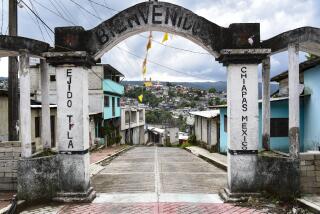Under Pressure to Solve Crisis, Mexico Turns to the Land : Revolt: Ecologists fear Chiapas rain forest may be sacrificed to appease rebels. There is no other acreage to be distributed.
- Share via
SAN CRISTOBAL DE LAS CASAS, Mexico — As negotiations to end the 7-week-old Indian uprising entered their second day Tuesday, environmentalists worried that North America’s last rain forest could be sacrificed in the search for a solution to the land problem that is a major issue in the talks.
The remains of the once-extensive Lacandon rain forest in the southern state of Chiapas, where insurgents launched a New Year’s Day rebellion, are protected as the Montes Azules Biosphere Reserve. But that protection could prove fragile under pressure to end the conflict, which turns in part on the rebels’ demands that more land be given to local peasants.
“We are extremely concerned that among the solutions proposed will be subdividing the jungle,” said Ignacio March, a researcher at the Southeastern Ecology Research Center here. “There is no other federal land in the state that can be distributed. The risk is very high.”
For two decades, the jungle was the solution, southern Mexico’s safety valve. Landless peasants could relocate to the Lacandon jungle and get their own plot of turf. Between 1970 and 1990, the population of Ocosingo, the huge township in Chiapas that contains the rain forest, quadrupled to 120,000, destroying 80% of the Lacandon.
That safety valve closed four years ago when logging--which provided extra income for peasants who subsisted by farming corn, beans and coffee--was banned. Although some trees are still cut illegally, clearing the forest now means risking prison, especially for the poor, who cannot pay fines or bribes.
Thus the pressure for land began to build, becoming a significant factor in the uprising that shook Mexico on Jan. 1. Now, environmentalists worry that the government will consider allowing destruction of the rain forest to provide a short-term solution to the rebels’ demand for land.
“It is easy to tell peasants, ‘I’ll give you a piece of land,’ ” said Yosefa Ugav, a researcher at Casa Na Bolom, a think tank that has studied the rain forest for decades. “But the solution should not be the reserve.”
How the land should be used, and by whom, is at the heart of the negotiations between the government and rebels who took over several towns Jan. 1 and still control most of the jungle.
Leaders of the Zapatista National Liberation Army, as the insurgents call themselves, met Tuesday with representatives of half a dozen political parties to reinforce their insistence that national political issues be included in the negotiating agenda.
Without specifying what issues will be discussed, both sides indicated at a late afternoon press conference that talks are going well.
“We have found ears that listen to us and enthusiasm for finding solutions,” said Subcommander Marcos, the Zapatistas’ spokesman. He added that the process is slow because all communications from government peace commissioner Manuel Camacho Solis must be translated into four Indian languages so that the 18 Zapatista delegates can understand them.
Mediator Samuel Ruiz, bishop of San Cristobal, said that the Zapatistas presented a list of demands including national, state and indigenous issues and that Camacho Solis replied to it. He did not say what was in either document.
However, Camacho Solis appeared to have softened his opposition to the inclusion of national issues in the negotiations. “It is clear that the way to a peaceful end in Chiapas is new replies from the state . . . and a commitment to democracy in Mexico,” he said.
Whatever progress the delegates may have made Tuesday, clearly what most concerns the Zapatistas and their followers is land.
“All they tell us is not to cut trees, not to burn the land, but how can we not do so when we must eat?” asked one woman who trained with the Zapatistas and, like most of the rebels, lives in a village at the edge of the jungle.
Peasants are already encroaching on the western edge of the 728,000-acre reserve, Na Bolom researchers have found.
“The reserve is defined on a piece of paper, but not in the jungle,” Ugav said.
“We are willing to preserve the jungle if they would send us machinery to work the land we have,” the Zapatista woman, who asked not to be identified, said during an interview in her jungle village. “If they would help us, we would be the first in taking care of the jungle.”
Privately, government sources close to the negotiations say they believe solutions can be found that will both preserve the rain forest and solve the problems of the peasants. They declined to be more specific.
Ugav advocates a more radical solution: “They should divide the land (in other parts of the state) more fairly.”
More to Read
Sign up for Essential California
The most important California stories and recommendations in your inbox every morning.
You may occasionally receive promotional content from the Los Angeles Times.










